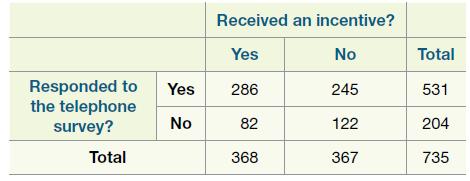A team of researchers (Singer etal., 2000) used the Survey of Consumer Attitudes to investigate whether incentives
Question:
A team of researchers (Singer etal., 2000) used the Survey of Consumer Attitudes to investigate whether incentives would improve the response rates on telephone surveys. A national sample of 735 households was randomly selected, and all 735 of the households were sent an “advance letter” explaining that the household would be contacted shortly for a telephone survey. However, 368 households were randomly assigned to receive a monetary incentive along with the advance letter, and the other 367 households were assigned to receive only the advance letter. Here are the data on how many households responded to the telephone survey.

a. Was this an observational study or an experiment? How are you deciding?
b. What are the observational units?
c. What are the variables recorded? For each variable, identify the type of the variable (categorical or quantitative) and the role of the variable (explanatory or response).
d. Did the study involve random sampling? If yes, what is the advantage of a randomly selected sample? If no, what is the disadvantage?
e. Did the study involve random assignment to either receive an incentive or not? If yes, what is the advantage? If no, what is the disadvantage?
f. An appropriate analysis of the data shows there is evidence that people receiving an incentive are more likely to respond to the telephone survey compared to those receiving no incentive. Is it appropriate to conclude that incentives improve response rates? Why or why not? Explain your reasoning.
Step by Step Answer:

Introduction To Statistical Investigations
ISBN: 9781118172148
1st Edition
Authors: Beth L.Chance, George W.Cobb, Allan J.Rossman Nathan Tintle, Todd Swanson Soma Roy





